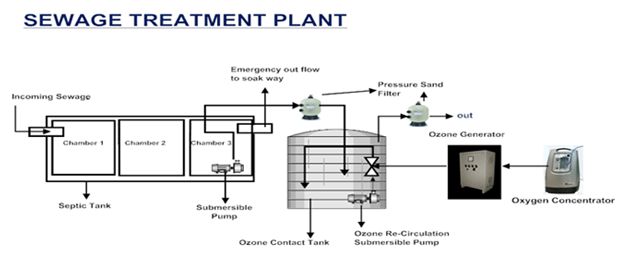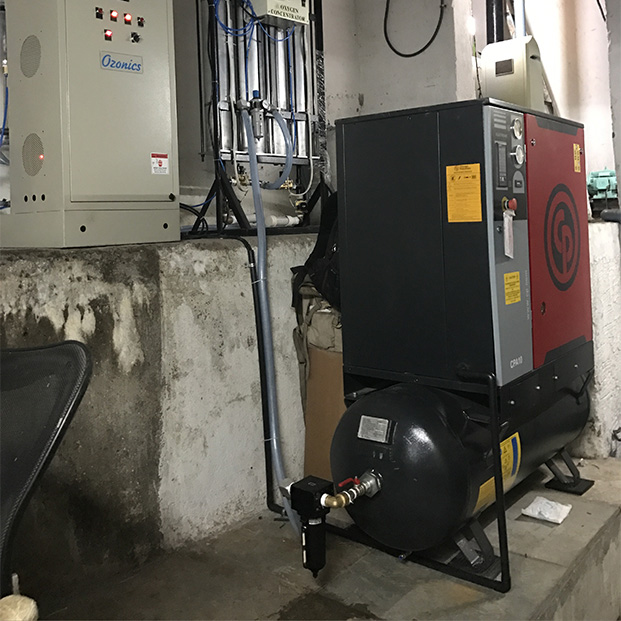Optimal treatment of wastewater is a challenge faced by many municipalities and organisation throughout the world. Disinfection is the primary mechanism for inactivation/destruction of pathogenic organisms to prevent the spread of waterborne diseases to downstream users and the environment.
Ozone is a very strong oxidant as well as bactericidal agent. It is increasingly used at sewage treatment plants for disinfection of treated effluent. When ozone dissolves in water, hydroxyl (OH) free radicals are formed having great oxidising capacity. Micro organisms are destroyed by protoplasmic oxidation resulting in cell lysis.

Ozone is used for improved disinfection, reduction in disinfection byproduct and increasing the oxygen content of water. The effectiveness of disinfection depends on the susceptibility of the target organisms, the contact time, and the concentration of the ozone.
The use of ozone along with biological treatment can be a very costeffective and efficient solution for wastewater treatment. Extension of ozone to the activated sludge process may further improve wastewater treatment plant economics and performance. Combined with filtration, Ozone provides an optimised chemical and biochemical oxidation. Unlike systems that only displace pollution by producing large amounts of sludge (e.g. precipitation with salts and flocculation) or by producing a concentrate of this pollution (e.g. with membranes), ozone really eliminates the pollution and produces only a small amount of biological sludge.
The Process
Untreated sewage from a property flows into the septic tank and the solids are separated from the liquid. Solid material is separated depending on their density. Heavier particles settle at the bottom of the tank whereas lighter particles, such as soap scum, will form a layer at the top of the tank. Raw sewage is treated by maceration with a grinder pump which increases surface area for ozone reactions.
The liquid then is pumped into a sand filter. From the sand filter the liquid is collected in a tank. Next step is primary advanced oxidation system using ozone (Pre-treatment). Ozone is used to partially oxidises larger organic material (BOD) and oil and grease (O/G). The water is ozonated to 100 ppm. Ozone partially oxidises organic material: large molecules and refractory materials are broken down into smaller biologically degradable molecules that can be removed by filtration. Sewage ozonated in such a manner shows a considerable reduction in COD, BOD, TSS and turbidity.
The second process is an aeration phase where condensed oxygen is diffused to promote biological growth. The broken down material from the primary treatment process and the oxygen allow for accelerated biological growth, increasing biological treatment efficiency. Biological (anaerobic) processes are used to help degrade the solid materials. This treated water can be directly used for agriculture purposes. The water is then filtered in fine sand filter and activated carbon filter and then reozonated as a final polishing and disinfection.

Lastly, the mixed liquor from the second process is transferred to the ozone polishing stage. Here, advanced oxidation with ozone causes further reduction of biochemical oxygen demand (BOD) and total suspended solids (TSS), removal of all colour and disinfection of final effluent. Ozone also oxidises hydrogen sulphide and volatile organic material, eliminating odour. This treated water can be used for flushing, car washing, gardening cooling tower feed, etc.
In the activated sludge process, ozone damages certain sludge bacteria so they can be consumed by rest of the bacteria (biomass or sludge). This process can cause up to 60% reduction in excess sludge. Other benefits include: elimination of foaming problems, reduction in bulking, improvement in dewatering, improvements in settling and improvement in effluent quality. The absence of sludge and the significant decrease in BOD and COD suggest that the organic material was totally oxidises and removed as carbon dioxide gas. This removal eliminates the need for sludge to be trucked into municipalities for treatment and stabilisation and results in substantial cost savings.
Recent Comments